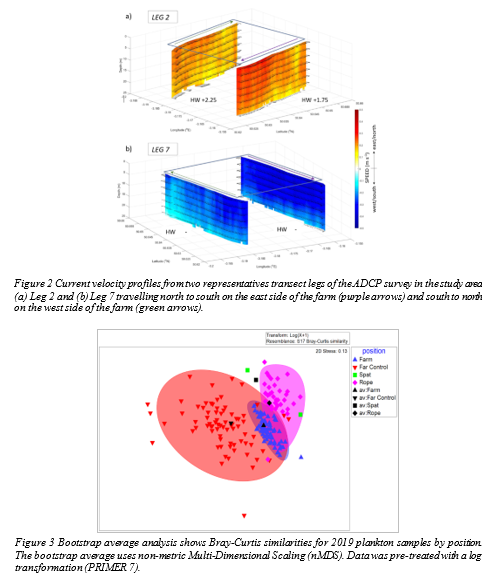OCEANOGRAPHIC AND ECOLOGICAL INTERACTIONS WITH AN OFFSHORE, LONG-LINE MUSSEL FARM
Introduction
Bivalve aquaculture has traditionally been established in shallow, sheltered waters in inshore areas generating notable negative environmental impacts due to the accumulation of waste products. However, the recent global expans ion of the offshore industry is perceived to have a lower environmental impact coupled with a higher growth potential. Mussels can positively contribute to marine ecology as carbon storage, nutrient remediation and coastal defence. Hence, the development of offshore aquaculture has the potential to provide the most sustainable source of protein to feed our growing population.
In 2013, the University of Plymouth commenced a robust annual monitoring study of the UK’s 1st large scale offshore mussel farm in Lyme Bay, south west UK. Using a range of underwater survey vehicles and sampling techniques, the study has been valuable in showing ecological interactions such as the potential to increase habitat value and increase commercially valuable mobile species (
) .
Aims
This PhD aims to assess the overall footprint of this offshore mussel farm, focusing on the effects that the farm has on the oceanography and plankton, while maintaining the long-term ecological surveys during three more survey seasons . The study will focus on how currents and waves are modified by the structure and the consequent impact on the surrounding ecology. The focus is specifically on sediment transport and plankton depletion as well as the functional change of benthic and commercially targeted species.
Methodology
For the oceanographic study, c urrent velocity data was collected with a boat mounted Acoustic Doppler Current Profiler (ADCP) through an entire tidal cycle during spring tides. A fixed bedframe ADCP will also be placed on the farm to further study water column profiles. For the ecological study, benthic epifauna is being quantified through Towed HD video array, ROV and Baited Remote Underwater Video (BRUV) while pelagic epifauna is being quantified using Non-baited Midwater Video rigs (NMV). Sediment and infauna communities are being quantified by sediment grabs and laboratory analysis whereas plankton communities have been sampled using a plankton mesh throughout the entire water column and identified to species level at the laboratory.
Results
Oceanographic and ecological data is being analyse and will be shown during the oral presentation. Preliminary observation of results show that the presence of the mussel farm is having an effect on the speed and direction of the flow, both at ebb and flood tides (
) as well as the abundance and type of zooplankton (
).

